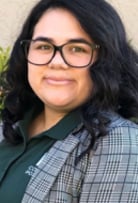Recently we sat down with two Catalyze near-peer success coaches to ask how they are supporting their students transitions from in person to remote learning. Norma Zheng is a dedicated coach and leader at Vaughn College of Aeronautics and Technology, and Rachel Riojas is a passionate coach with a strong voice from California State University, Stanislaus.
What inspired you to become a College Possible success coach and AmeriCorps member?
 Rachel: My passion for helping underserved populations in higher education inspired me to become a College Possible success coach and AmeriCorps member. I know firsthand how challenging it can be to come from intergenerational poverty and be the first person in your family to go to college. My mentors in the past and present have helped guide in my educational journey and I would like to do the same for other students.
Rachel: My passion for helping underserved populations in higher education inspired me to become a College Possible success coach and AmeriCorps member. I know firsthand how challenging it can be to come from intergenerational poverty and be the first person in your family to go to college. My mentors in the past and present have helped guide in my educational journey and I would like to do the same for other students.
 Norma: As an undergraduate, I majored in Peace and Justice Studies with a focus on Education; I loved working with students, I believed wholeheartedly in the power of education, and I wanted to understand how existing systems and structures could be improved to help make education a true lever for positive change. Having been a first-generation, low-income college student myself, I experienced many of the same challenges my own College Possible students are facing today, academically, financially, socially, and emotionally. As an AmeriCorps member and College Possible Coach, I have been able to help prevent students from falling through the cracks, connecting them to the right resources, empowering them to believe in themselves, and challenging them to keep moving forward. Like so many other College Possible Coaches, I was immediately drawn to the role because I knew how impactful a college success coach would have been in my own college experience.
Norma: As an undergraduate, I majored in Peace and Justice Studies with a focus on Education; I loved working with students, I believed wholeheartedly in the power of education, and I wanted to understand how existing systems and structures could be improved to help make education a true lever for positive change. Having been a first-generation, low-income college student myself, I experienced many of the same challenges my own College Possible students are facing today, academically, financially, socially, and emotionally. As an AmeriCorps member and College Possible Coach, I have been able to help prevent students from falling through the cracks, connecting them to the right resources, empowering them to believe in themselves, and challenging them to keep moving forward. Like so many other College Possible Coaches, I was immediately drawn to the role because I knew how impactful a college success coach would have been in my own college experience.
How have you supported students throughout their transition to remote and online classes?
Norma: For many of my students, the transition to Zoom classes has meant less opportunities to get to know their classmates and feel connected to their campus, in addition to increased difficulty paying attention during classes, staying motivated to succeed, and managing time effectively when the separation between “school” and “home” has become so porous. Through consistent check-ins by text, email, phone, and Zoom calls, I have been able to lend an ear when needed, provide encouragement and suggestions, as well as challenge students to help problem-solve for themselves, whether that be setting new goals or trying out new tools or strategies. To help build a space where my students can connect with other College Possible students at the school, I have helped host eleven game nights so far, with weekly game nights planned for the rest of the semester.
Rachel: Taking online classes during a national pandemic brings an inevitable amount of stress for students. Self-care can be neglected so I try to share different self-care tips to promote social-emotional wellness. I empathize with my students and try to provide a safe place for them to vent out their frustrations. Once the frustrations are out, we focus on making an academic success plan to keep them on track for a strong semester.
What advice would you give campus leaders about bringing near-peer coaches to their campus?
Rachel: I would advise campus leaders to bring near-peer coaches to their campus to boost student success. Since near-peer coaches are recent college graduates, they can provide their unique insight and mentorship that can make all the difference in a student’s experience. Additionally, there are no power dynamics in a near-peer coaching setup. It feels like I am an older sibling giving advice and empowering a younger sibling as they complete college.
Norma: To be able to serve our role as near-peer coaches as effectively as possible, we really depend on our campus leaders to help facilitate our integration with the college staff and faculty as thoroughly as possible. During the first month of my service, my program lead worked with other campus leaders to make sure we met with every relevant department at the school, from Academic Advising to Financial Aid to Career Services. This was essential to helping us gain a more nuanced understanding of the many varying roles and responsibilities performed by each of the different departments, as well as the culture and systems unique to our school. These meetings were critical for helping to prepare us to be able to interact with our students knowledgeably, so that we not only understand our students’ questions and concerns but can also guide them to the right resources and direct them to the right contacts. In addition, our first month of introductions and subsequent participation in several routine departmental meetings allowed us to build many new working relationships, as we learned who we could reach out to for different situations and found opportunities where we could collaborate with other departments to reach common goals.
What do you hope to pursue and accomplish following your service with AmeriCorps and College Possible?
Norma: Following my service, I hope to continue to work with youth from under-privileged backgrounds, in an educational or social work setting. I aspire to build on the coaching strategies we’ve learned over the last year, so that I may be a more effective speaker, empathetic listener, and experienced mentor. Above all, I hope to never lose sight of the meaning behind this challenging work, to remember the limitless impact each small gesture of support can bring to the lives of those I help serve.
Rachel: Following my service with AmeriCorps and College Possible, I plan on going to graduate school to pursue a master’s in social work. I have overcome an impoverished childhood, teenage pregnancy, and am the first person in my family to go to college. My service has allowed me to gain professional experience within the realms of student supportive services. I am passionate about being an advocate for others and hope to use that experience as I pursue my goal of becoming a leader of social change for underserved populations.



